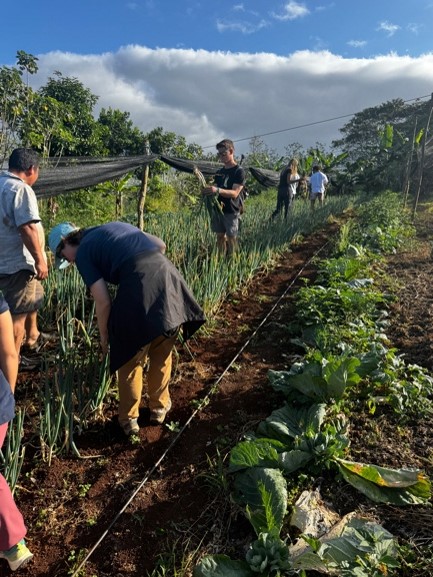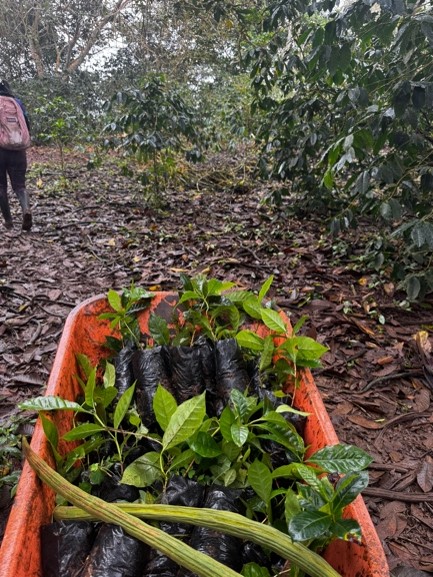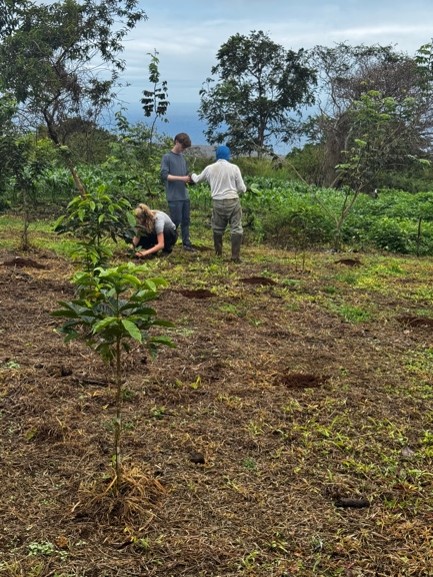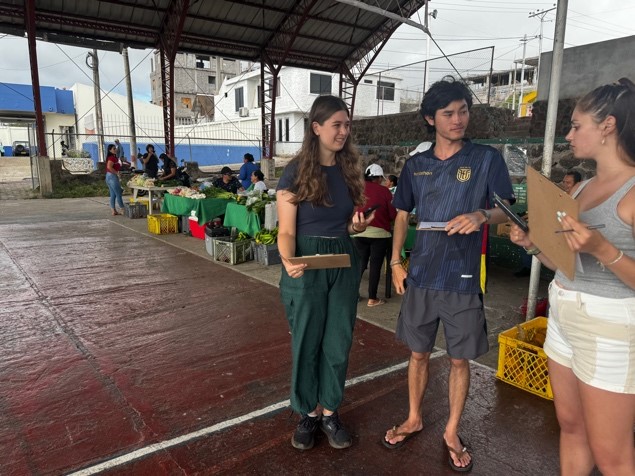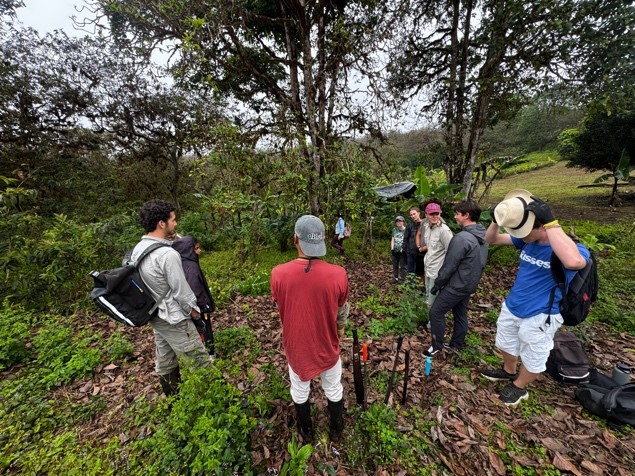Farm to Table, leakages, and challenges for food security in Galapagos Islands
09.04.2025
SUBMITTING ORGANIZATION
Universidad San Francisco de Quito USFQ
OTHER CONTRIBUTING ORGANIZATIONS
None
DATE OF SUBMISSION
20 February 2025
REGION
South America
COUNTRY
Ecuador
KEYWORDS
Agriculture, local sourcing, food security
AUTHORS
David Chacón, Diana Moreta, López Andrade Jaime Eduardo
Universidad San Francisco de Quito USFQ
Summary Sheet
The summary sheet for this case study is available here.
Background
The Galápagos Islands are known worldwide for their high level of ecological integrity. However, it is less widely known that they have a population of approximately 30,000 inhabitants distributed across four islands, with a fifth island containing infrastructure areas. The archipelago receives around 300,000 tourists per year, and tourism is the main economic activity. On each of the four inhabited islands, urban settlements are in the coastal zone, while rural settlements, along with agriculture and livestock production, occupy the higher elevations. The two most populated islands (Santa Cruz and San Cristobal) account for most of the economic activity because they offer the most tourist infrastructure.
97% of the archipelago’s surface is designated as a protected natural area, with the remaining 3% destinated for human settlements (Dirección del Parque Nacional Galápagos, 2014). In the lower coastal areas, hotel infrastructure caters to the many visitors arriving each year and provides the primary source of income for the 30,000 island residents. By contrast, the agricultural zone in the upper part of the larger islands benefits from soil conditions suitable for cultivation (Barrera et al., 2021). Nevertheless, there are different challenges that have limited and reduced the agriculture activity on the islands. First of all, water is a scarce resource that limit the production on two main seasons, being the dry/hot season (December – May) and the cold/rainy season (June – November) (Ministerio de Agricultura y Ganaderia, 2020). On the other hand, tourism has become the main source of income since the 1970, reducing the available workforce for the agriculture and a migration from the rural population to the urban area (Epler, 2007).
Socioeconomic and environmental characteristics of the area
In the first colonization and until 1970, the economy of the islands was primarily agricultural followed by fishing. After the mid-1970s, tourism became the main source of income for the inhabitants, causing agriculture to be abandoned. In the early years of colonization of the Galapagos, many animal and plant species were introduced, some of which have spread spontaneously, affecting the environment. As a result, eradication and mitigation projects have been developed for these species with strict controls on the organic products that are introduced. The agricultural economy, not being developed, caused the farms to be abandoned.
By the time of the National Park creation, it was argued that agriculture was one of the main causes of invasive species spread in the archipelago. Nevertheless studies have shown that abandoned lands have higher incidence of invasive species than lands that are being used in agriculture and maintained (Khatun, 2018). In addition, the lack of local products has developed a dependency on food imports, being mainly processed products. This has affected the food security in the islands, and nowadays importation of products represents a threat for the local population health (malnutrition and obesity) and also is the main source of introduced species from the mainland (Sampedro et al., 2020). Together, the combination of a tourist industry disconnected from the territory and the community, and the lack of agricultural production have triggered ecological, public health and social development problems.
For some years now, efforts have been underway in the Galapagos Islands to seek a sovereign food production system that reduces dependence on the mainland and achieves a synergy between the products consumed by tourism companies and agricultural production, using sustainable techniques and products to care for the ecosystem (Jaramillo Díaz et al., 2022). There are several institutions working on these projects, which has led to a renewed interest in agricultural production, and experimental farms have begun to appear that seek methods to increase production and work with native plants, trying to position them in the Galapagos market. The Universidad San Francisco de Quito, as part of its community outreach projects, is working with producers and tourism companies to achieve an urban-rural connection that will increase sustainable agricultural practices hand in hand with tourism companies. The project described below is one of the efforts that USFQ is currently undertaking with the community in the Galapagos Islands.
Objective and rationale
The project aims to foster connections between the tourism industry and food production in Galapagos by strengthening sustainable agricultural production through a tourism industry focused on developing a Galapagos identity through sustainable practices. This main objective seeks to follow the following rationale to propose activities and strategies to approach the final objective.
1.- Generate food sovereignty in the Galapagos Islands by increasing the cultural values of the community through food. In the Galapagos Islands, the population is mainly made up of migrants or descendants of migrants from the Galapagos Islands. This has led to the assertion that Galapagos lacks culture. However, the human history of Galapagos is very rich and continuous, from the discovery of the islands to the present day, and there have been efforts to adapt to the islands. Many of these efforts have been reflected in the transformation of traditional Ecuadorian dishes with Galapagos products; Galapagos cuisine by nature combines mountain and sea food (Ahassi, 2007). It is hoped that the project will encourage the local population to define their own identity based on the mixture of cultures and the incorporation of local ingredients into their diets.
2.- Increase food security in the islands, the high dependence on the mainland for the supply of products has built communities vulnerable to external elements of the islands, such as mishaps of cargo ships. In the event of a ship mishap, the community is undersupplied, prices rise, and the needs of the tourism industry are affected, but even more so the nutritional needs of the community. When there are shortages, existing products are directed first to the tourist trade and then to the community. Increasing agricultural production will decrease dependence on the mainland. There is a high misconception about the local product in relation with its price, most of the population believe that is higher than the imported products and therefore the demand and offer are disconnected. This affects the growth of the agriculture industry on the islands.
3.- Reduce the risk of species introduction through cargo. One of the main risks to the ecological integrity of the Galapagos Islands is the introduction of species, and one of the main vectors is cargo ships, which, despite port controls, can easily introduce animals, insects, seeds or other organic forms that can easily spread. In addition, the cargo of perishable products such as fruits or vegetables is more likely to have insects or seeds of other species than inorganic cargo. Reducing food dependence on the mainland would undoubtedly reduce the number of ships arriving from the mainland.
4.- Gradual improvement of land cover in the water recharge zone of the inhabited islands. The inhabited islands have different ecological zones, the agricultural zone is in the humid ecosystem of Galapagos, which appears around 300 meters above sea level. These areas have replaced the natural soil cover with agricultural products and the spread of invasive species. Sustainable agriculture that works with endemic or native species and integrates agroforestry systems will serve to restore the soil cover to one more like the original, contributing to the health of the natural landscape (Paltán et al., 2023).
5.– Improve the quality of service in community tourism establishments. Community-run tourism establishments currently depend almost entirely on the supply of products from the mainland; in many cases, small hotels lag behind larger businesses due to the lack of products. While the former depend on daily supplies, which are scarce and expensive, the latter have storage capacity, giving them a competitive advantage. This translates into the perception of service among diners and passengers in restaurants and hotels.
Description of activities
This project seeks to develop capacities for continuous improvement in the quality of service in the tourism area of San Cristóbal and Santa Cruz. The year 2025 will be the first year that tourism exceeds pre-pandemic numbers. This growth also requires an evolution and improvement in the quality of service provided by tourism establishments. Now, studies show that tourist satisfaction in general is influenced by their experiences within the protected area and marine reserve. To improve the quality of service, it is necessary to map the current state of tourism services. This will be done with the support of students, who will strengthen their skills in market research and quantitative and qualitative data analysis. Subsequently, training will be conducted focused on the mapped weaknesses of service quality. With the support of industry professionals and tourism students who will encourage continuous improvement within the industry. On the other hand, there is currently a disruption between consumers and producers in the agricultural industry. In order to foster change, participatory workshops will be held in which students and industry professionals can connect with local producers. Through visits to different producers, both students and professionals will seek to reduce the gap between the agricultural community and consumers. Thus, revaluing the product and encouraging local consumption in both the tourism industry and the local population.
The project includes specialists in international programs, sustainable tourism, gastronomy and food security. They will conduct surveys, continuous improvement activities for production and participatory workshops with professionals, students and other community members. These activities are oriented to capacity building actions ranging from the use of native products in recipes to the improvement of the quality of service, pest control initiatives, improvement of plots for agricultural production and workshops that integrate the different actors of the community to recognize common interests and achieve commitments and solutions to possible difficulties that until now have been the impediment to this type of urban-rural synergy. Each activity generates an indicator to measure the impact on the community.

Results and lessons learned
The project is in progress, the first surveys have been obtained, and the first production systems have been evaluated. The direct beneficiaries of the project and the agricultural technologies that are in the process of implementation have been evaluated. The project is being carried out on the two most populated islands of the archipelago: Santa Cruz Island, with the city of Puerto Ayora and the rural parishes of Bellavista and Santa Rosa, and San Cristóbal Island, with the rural parish of El Progreso, which in turn are the two most productive islands from an agricultural and tourism point of view.
An estimated 3,628 people are directly employed in the tourism industry within the Galapagos Islands. Of these, 66% are focused on establishments located within Santa Cruz and San Cristóbal. The primary community for the present project will be those in the tourism industry in land-based establishments, focusing on Santa Cruz and San Cristóbal as a first stage.
With this data, the population of beneficiaries is 2395, of which 64% are men and 36% are women. 1090 of the jobs related to tourism are in the lodging sector, which is why this project will focus primarily on lodging. In addition, the Universidad San Francisco de Quito USFQ is working with the HEIFER organization, which has already integrated 250 farmers, producers, and entrepreneurs into the Future of Food in Galapagos project. Strengthening the integration of efforts in the archipelago. It is important to note that the majority of this population are women leaders in agriculture. Over the years, the Universidad San Francisco de Quito has worked with several host families from the Galapagos community who support the international programs that USFQ has at its Galapagos headquarters. Among the beneficiaries of the project will also be included this community, which currently numbers 80 families, 98% of whom are mothers and household leaders.
Different techniques are currently being tested to improve production, such as macro tunnels and light structures for controlled production, agricultural systems to maintain soil moisture and control weeds such as mulching, as well as anti-bird netting to prevent birds from entering the crops. All of these activities are permanently monitored to observe the production process and minimize the risk of affecting the ecosystem. We are currently working with different farms to monitor the results of the technologies introduced. In addition, we are working together with experimental farms aimed at capacity building.
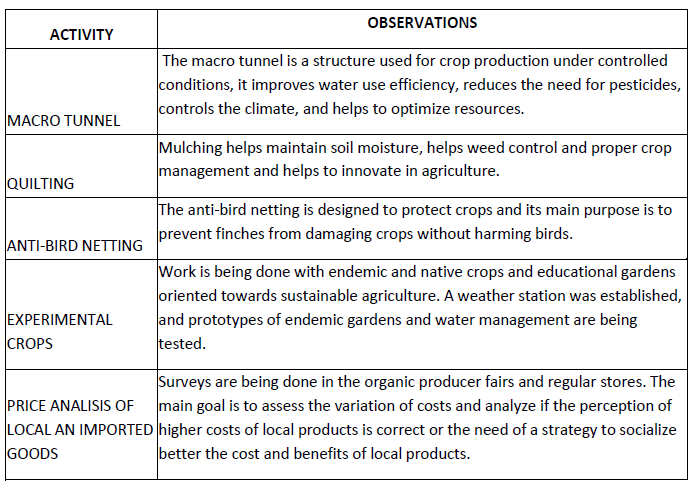
References and Bibliography
Ahassi, C. (2007). LO GALAPAGUEÑO , LOS GALAPAGUEÑOS . Revista de Antropología Experimental, 7, 169–176.
Barrera, V., Monteros-Altamirano, Á., Valverde, M., Escudero, L., Allauca, J., & Zapata, A. (2021). Characterization and Classification of Agricultural Production Systems in the Galapagos Islands (Ecuador). Agricultural Sciences, 12(05), 481–502. https://doi.org/10.4236/as.2021.125031
Dirección del Parque Nacional Galápagos. (2014). Plan de Manejo de las Áreas Protegidas de Galápagos para el BUEN VIVIR.
Jaramillo Díaz, P., Calle-Loor, A., Gualoto, E., Bolaños, C., & Cevallos, D. (2022). Adoption of Sustainable Agriculture Practices through Participatory Research: A Case Study on Galapagos Islands Farmers Using Water-Saving Technologies. Plants, 11(21). https://doi.org/10.3390/plants11212848
Paltán, H. A., Benítez, F. L., Narvaez, M., Mateus, C., & Mena, C. F. (2023). Water security and agricultural systems in the Galapagos Islands: vulnerabilities under uncertain future climate and land use pathways. Frontiers in Water, 5. https://doi.org/10.3389/frwa.2023.1245207
Epler, B. (2007). Tourism, the Economy, Population Growth, and Conservation in Galapagos.
Khatun, K. (2018). Land use management in the Galapagos: A preliminary study on reducing the impacts of invasive plant species through sustainable agriculture and payment for ecosystem services. Land Degradation & Development, 29(9), 3069–3076. https://doi.org/10.1002/ldr.3003
Ministerio de Agricultura y Ganaderia. (2020). Boletin zonal Galapagos Octubre 2020 http://sipa.agricultura.gob.ec
Sampedro, C., Pizzitutti, F., Quiroga, D., Walsh, S. J., & Mena, C. F. (2020). Food supply system dynamics in the Galapagos Islands: Agriculture, livestock and imports. Renewable Agriculture and Food Systems, 35(3), 234–248. https://doi.org/10.1017/S174217051800053
Web links of relevant organizations:
Photos and evidence:
Main Author´s profile
David Chacón is a tourism and hospitality professional specializing in sustainable tourism, community development, and heritage conservation. With experience in academia, international program coordination, and impact measurement, he bridges research, education, and industry. His work integrates sustainability, cultural heritage, and experiential learning to foster responsible tourism initiatives worldwide.


